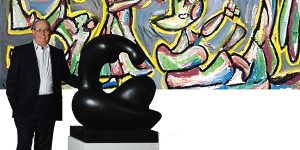Here he is, Frank Hyder painting: it can be keen with a stroke and overwhelming with a brushstroke. His characters have a wicker skin, the epidermis becomes an enchantment of carved wood, chips and shells, a bamboo masking. He is a colorist that moves his tonalities as wind in foliage, as swirl in water, as fire in the mountains.
When Frank Hyder paints, with simple ways the significance of the things that matter and that highlight the human course, that trail that has left its traces in Olympus and swamps, in forests and rocks, in the sap and the bark, in the spirit and the flesh.
There is no sloppiness or laziness in his occupation: he exercises it with the same passion as those artists of all times, and that significant intensity, transforms any of his paintings in a door that cross the most unknown and dissimilar cultures.
That implicit transcendence in the work of Hyder, invariably catapults his work into the field of museums. It's like the eagle's flight, which true to its essence, ends the ellipsis at the top of the mountain range. Although the development of his creative personality was showing in diligent galleries of the United States and Latin America, his pieces go beyond the privacy of small spaces, attract the interest of research and the whirlwind of the spectators. These, invariably experience a tremor of pilgrims when they discover the faces hanging in the mystery of his canvases.
The face and the environment
Criticism has emphasized his persistence in defending the environment and indigenous cultures throughout the Americas. His painting has been immersed in the materials and colors that evoke the life of man planted in the jungle and in history.
But Frank Hyder has macerated a vital nerve, he has found a bent that serves him to remove the flares of myth and poetry: one of his paintings can become something so new and old at once as a sunset.
Because in reality and the delusions of his studio, the artist has been driven to the lands where there reigns the most important symbol of all: the human face, the face of man.
All civilizations that flourished and withered on the planet, all high cultures that motivated the human being to debate between the search of knowledge and the discovery of faith, they are still poking to the present through faces carved in stone, cast in bronze, carved in wood or baked in perennial mud. They dominate in Asian, African, European, American temples, and jump to the mind just by saying the specific names such as Sphinx, Greece, Rome, Burma, Thailand, India, China, Buddha, Maya, Aztec, Cuzco, Easter Island.
The face is the book where are written the feelings and thoughts of the human being. "When man turns his face toward the light, his face shines with clarity." This could be applied in the way of seeing, in the light of the tropics, those faces that Hyder reveals using the colors of the American passion.
Face and religiosity
When the pagan idols fell and God was just one, the temples could not show his image, because nobody knows his face. They insisted, then, that man was made by the Lord in His image and likeness. The human face was there to show a possible feature of the Almighty. Pope Gregory the Great, at the end of the VI century, said many church members could not read and that it did not hurt to teach through painting the word of God.
The sacred texts have emphasized: "The face of God relates to his essence, and therefore it is impossible to contemplate it."
And although it has been said that "Nobody has ever seen God," in Chapter 4 of Apocalypse, John, the theologian, said he saw: "... a throne set in heaven, and on the throne, one sitting. And the aspect of the one that sat there was similar to a jasper and carnelian stone, and around the throne there was a rainbow, resembling an emerald. "
Jasper and Carnelian. Frank Hyder creates and recreates faces in a similar way. And he also paints faces, that in turn, in the narrative of his stories are painted to give continuity to the rituals of life and death, peace and war, of initiation and hope.
The face is a subject that covers everything: it is like a religion in itself. Anyone can get lost in ramblings about it, but it is imperative to assert: no one has been able to see his face directly.Man is allowed only to watch and know his face through the mirror or portrait. Others only look at the faces of the other and vice versa.
The face suffers in the open, but it keps the dreams and the five senses and it gives it more meaning to the painting of Frank Hyder. He has understood that the face is eternal, like roses and birds. The face represents the full-length human being: it is in the identification cards, passports, on the tombstones and posters, on billboards and in the halls of fame.
New Zealand’s Maoris have preserved their identity in wooden faces; in Nigeria appeared bronze heads so perfect that with them it is possible to know, with certainty, how the Nigerians lived and thought of such distant past. Tlaloc, the Aztec god of rain, brought into the present a face made of snakes, as if the medusa had watched itself, and the serenity of the Buddha shines in a head of the third century made by the Gandhara school.
And speaking of lessons: here is the school of Frank Hyder, based on ancient meanings and contemporary truths. A series of paintings, so that future spectators learn the art of a man who mixing colors and loves, invokes the salvation of trees and animals, of forests and rivers. Here is the painter tied to a fondness and looking eagerly as a child, the formula for man and nature not to continue divorcing. For this reason is that his faces bloom in the poetics of the plant kingdom. The artist never takes a mundane job, because he uses his workshop as cosmos. No wonder it is said on urban land and in the suburbs, that God inspires the artists, morning and night, so that they despair acting in his own image and likeness.

Interview with Mr. Tomás Kepets, director of the Medicci Gallery
Read more
"During those two decades, Galeria Medicci advanced into a river of creations and continues to show the majors artists, the vanguard of every moment, lucidity and everything that bridges with spiritual values. The experiences accumulated in more than two decades have sharpened the dynamics of today ". José Pulido
Works of renowned artists in the United States, the Caribbean and Latin America such as Manuel Mendive, Carlos Luna and the American sculptor Manuel Carbonell, as well as Venezuelan expats based in Paris, France, Annette Turrillo and Karim Borjas.